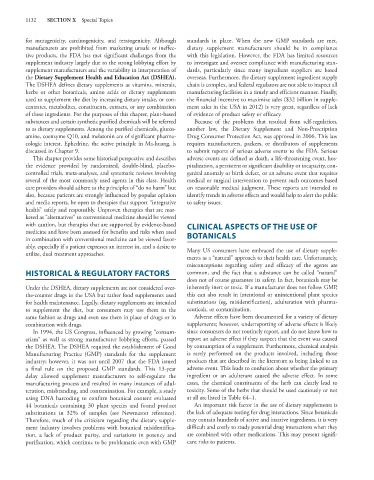Page 1146 - Basic _ Clinical Pharmacology ( PDFDrive )
P. 1146
1132 SECTION X Special Topics
for mutagenicity, carcinogenicity, and teratogenicity. Although standards in place. When the new GMP standards are met,
manufacturers are prohibited from marketing unsafe or ineffec- dietary supplement manufacturers should be in compliance
tive products, the FDA has met significant challenges from the with this legislation. However, the FDA has limited resources
supplement industry largely due to the strong lobbying effort by to investigate and oversee compliance with manufacturing stan-
supplement manufacturers and the variability in interpretation of dards, particularly since many ingredient suppliers are based
the Dietary Supplement Health and Education Act (DSHEA). overseas. Furthermore, the dietary supplement ingredient supply
The DSHEA defines dietary supplements as vitamins, minerals, chain is complex, and federal regulators are not able to inspect all
herbs or other botanicals, amino acids or dietary supplements manufacturing facilities in a timely and efficient manner. Finally,
used to supplement the diet by increasing dietary intake, or con- the financial incentive to maximize sales ($32 billion in supple-
centrates, metabolites, constituents, extracts, or any combination ment sales in the USA in 2012) is very great, regardless of lack
of these ingredients. For the purposes of this chapter, plant-based of evidence of product safety or efficacy.
substances and certain synthetic purified chemicals will be referred Because of the problems that resulted from self-regulation,
to as dietary supplements. Among the purified chemicals, glucos- another law, the Dietary Supplement and Non-Prescription
amine, coenzyme Q10, and melatonin are of significant pharma- Drug Consumer Protection Act, was approved in 2006. This law
cologic interest. Ephedrine, the active principle in Ma-huang, is requires manufacturers, packers, or distributors of supplements
discussed in Chapter 9. to submit reports of serious adverse events to the FDA. Serious
This chapter provides some historical perspective and describes adverse events are defined as death, a life-threatening event, hos-
the evidence provided by randomized, double-blind, placebo- pitalization, a persistent or significant disability or incapacity, con-
controlled trials, meta-analyses, and systematic reviews involving genital anomaly or birth defect, or an adverse event that requires
several of the most commonly used agents in this class. Health medical or surgical intervention to prevent such outcomes based
care providers should adhere to the principles of “do no harm” but on reasonable medical judgment. These reports are intended to
also, because patients are strongly influenced by popular opinion identify trends in adverse effects and would help to alert the public
and media reports, be open to therapies that support “integrative to safety issues.
health” safely and responsibly. Unproven therapies that are mar-
keted as “alternatives” to conventional medicine should be viewed
with caution, but therapies that are supported by evidence-based CLINICAL ASPECTS OF THE USE OF
medicine and have been assessed for benefits and risks when used BOTANICALS
in combination with conventional medicine can be viewed favor-
ably, especially if a patient expresses an interest in, and a desire to
utilize, dual treatment approaches. Many US consumers have embraced the use of dietary supple-
ments as a “natural” approach to their health care. Unfortunately,
misconceptions regarding safety and efficacy of the agents are
HISTORICAL & REGULATORY FACTORS common, and the fact that a substance can be called “natural”
does not of course guarantee its safety. In fact, botanicals may be
Under the DSHEA, dietary supplements are not considered over- inherently inert or toxic. If a manufacturer does not follow GMP,
the-counter drugs in the USA but rather food supplements used this can also result in intentional or unintentional plant species
for health maintenance. Legally, dietary supplements are intended substitutions (eg, misidentification), adulteration with pharma-
to supplement the diet, but consumers may use them in the ceuticals, or contamination.
same fashion as drugs and even use them in place of drugs or in Adverse effects have been documented for a variety of dietary
combination with drugs. supplements; however, underreporting of adverse effects is likely
In 1994, the US Congress, influenced by growing “consum- since consumers do not routinely report, and do not know how to
erism” as well as strong manufacturer lobbying efforts, passed report an adverse effect if they suspect that the event was caused
the DSHEA. The DSHEA required the establishment of Good by consumption of a supplement. Furthermore, chemical analysis
Manufacturing Practice (GMP) standards for the supplement is rarely performed on the products involved, including those
industry; however, it was not until 2007 that the FDA issued products that are described in the literature as being linked to an
a final rule on the proposed GMP standards. This 13-year adverse event. This leads to confusion about whether the primary
delay allowed supplement manufacturers to self-regulate the ingredient or an adulterant caused the adverse effect. In some
manufacturing process and resulted in many instances of adul- cases, the chemical constituents of the herb can clearly lead to
teration, misbranding, and contamination. For example, a study toxicity. Some of the herbs that should be used cautiously or not
using DNA barcoding to confirm botanical content evaluated at all are listed in Table 64–1.
44 botanicals containing 30 plant species and found product An important risk factor in the use of dietary supplements is
substitutions in 32% of samples (see Newmaster reference). the lack of adequate testing for drug interactions. Since botanicals
Therefore, much of the criticism regarding the dietary supple- may contain hundreds of active and inactive ingredients, it is very
ment industry involves problems with botanical misidentifica- difficult and costly to study potential drug interactions when they
tion, a lack of product purity, and variations in potency and are combined with other medications. This may present signifi-
purification, which continue to be problematic even with GMP cant risks to patients.

